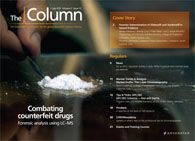Seal Sickness
A recent study has used a method designed to test human blood to confirm the presence of ciguatoxins in living seals.

In 1978 50 Hawaiian monk seals died mysteriously. Scientists at the time believed that ciguatoxins were responsible but at the time lacked the tools to test for the toxins directly. A recent study has used a method designed to test human blood to confirm the presence of ciguatoxins in living seals.1
Ciguatoxins are neurotoxins, produced by algae, which build up in fish that are then eaten by the critically endangered Hawaiian monk seal. In investigating the levels of seal exposure the researchers used a Neuro-2A cytotoxicity assay to quantify ciguatoxin activity, and liquid chromatography–tandem mass spectrometry to confirm the molecular structure.
According to the study, tissue analysis from dead stranded animals revealed ciguatoxin activity in brain, liver and muscle. Analysis of blood samples from 55 free-ranging seals revealed high levels of ciguatoxin activity in 19% of the animals. Samples from animals in shoreline pens had no toxin in their blood. In some cases blood samples from the exposed seals contained toxin levels as high as several picogrammes per millilitre, which is a high enough level to kill a rat.
The study provides the first confirmation that Hawaiian monk seals are exposed to significant levels of ciguatoxins and the first evidence of transfer of ciguatoxin to marine mammals.
1. M.-Y. Dechraoui Bottein et al., Environ. Sci. Technol., 45(12), 5403–5409 (2011).
This story originally appeared in The Column. Click here to view that issue.

.png&w=3840&q=75)

.png&w=3840&q=75)



.png&w=3840&q=75)



.png&w=3840&q=75)











